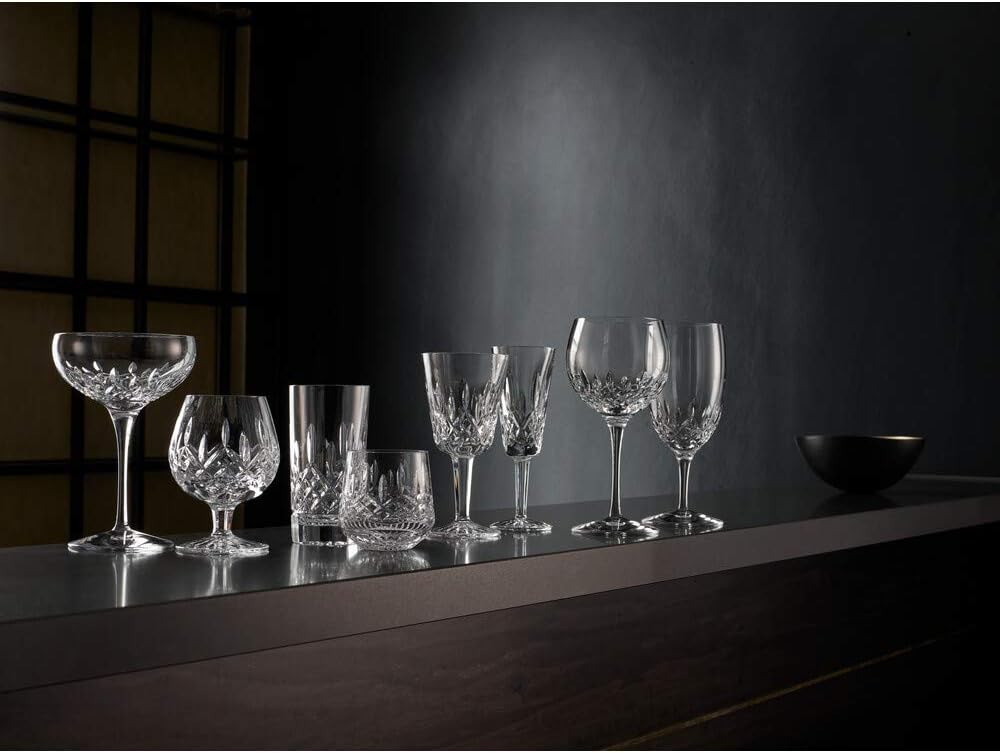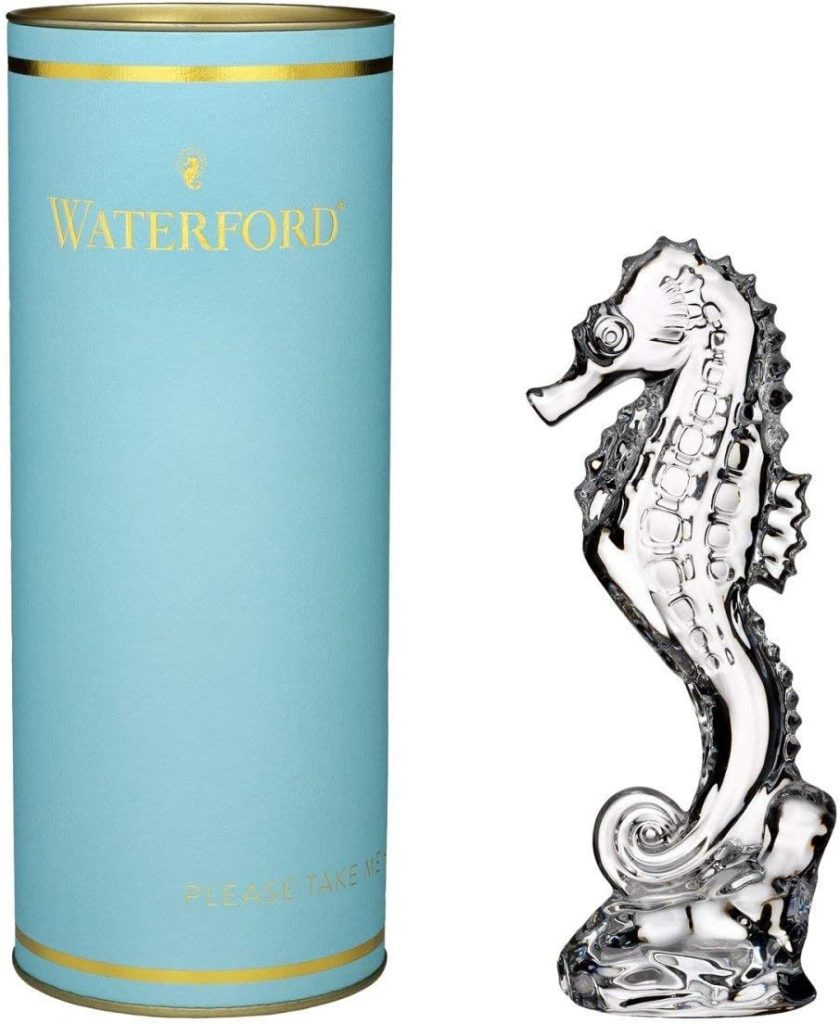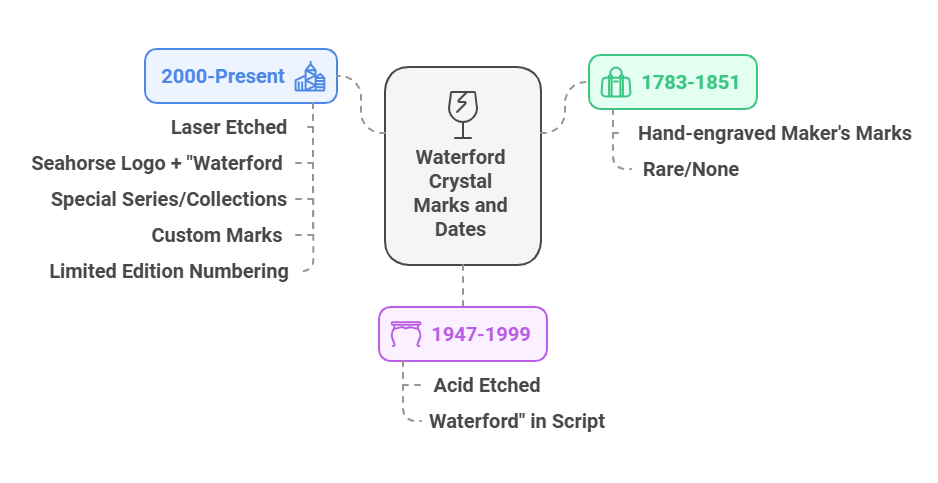You’re browsing through an antique shop when a gleaming piece of crystal catches your eye.
The shopkeeper claims it’s authentic Waterford, but how can you be certain?
Whether you’re a seasoned collector or inherited your grandmother’s prized crystal collection, understanding Waterford Crystal markings is like learning a secret language that opens doors to the fascinating world of fine crystal collecting.
Today, we will unlock that knowledge, helping you distinguish genuine pieces from clever imitations, and perhaps even discover hidden treasures gathering dust in your china cabinet.
WHAT IS WATERFORD CRYSTAL MADE OF?
Waterford crystal is made of lead crystal, which contains:
- Silica (sand)
- Lead oxide (minimum 24% for full lead crystal)
- Potash
- Other trace minerals
- Lead crystal – a “crystal”-clear, strong, durable compound that chimes when tapped with the fingers and feels warm in the hand.
IS WATERFORD CRYSTAL MADE IN CHINA?
No, authentic Waterford crystal is made in Ireland at the House of Waterford Crystal facility in Waterford, Ireland, where traditional Irish craftsmanship is maintained.
IS WATERFORD LEAD CRYSTAL OR IS WATERFORD CRYSTAL LEADED?
Yes, authentic Waterford crystal is lead crystal, containing at least 24% lead oxide, which gives it its distinctive weight, clarity, and brilliance.
WHAT DOES THE WATERFORD CRYSTAL MARK LOOK LIKE?
The Waterford mark typically appears as:
- “WATERFORD” in block letters, acid-etched
- Seahorse logo (used since 1947)
- Sometimes a combined logo with text
- Usually small and requires magnification to see clearly.
THE EVOLUTION OF WATERFORD CRYSTAL MARKS: A JOURNEY THROUGH TIME
When we delve into Waterford Crystal markings, we explore over two centuries of craftsmanship.

The story begins in 1783, in the bustling port city of Waterford, Ireland, where George and William Penrose established what would become one of the most prestigious crystal manufacturers in the world.
THE EARLY YEARS (1783-1851)
During Waterford’s initial period, pieces rarely carried marks, making the authentication of these earliest treasures particularly challenging. Experts primarily rely on:
– Design patterns characteristic of the period
– Quality of craftsmanship
– Historical documentation
– Scientific analysis of the glass composition
THE MODERN ERA (1947-PRESENT)
After a century-long hiatus, Waterford Crystal’s rebirth in 1947 brought standardized marking practices that have evolved:
1. Acid Etching (1947-1999)
The traditional acid-etched mark features:
– “Waterford” name
– Made in Ireland (on some pieces)
– Distinctive cursive script
2. Laser Etching (2000-Present)
Modern pieces showcase:
– Laser-etched “Waterford” name
– Seahorse logo
– Year of manufacture (on special pieces).
WATERFORD MARKS DATING
Waterford Crystal marking periods:
- Pre-1950: Primarily identified by green-and-gold seahorse paper stickers
- 1950s onwards: Acid-etched marks saying “Waterford” or featuring the iconic seahorse logo
- 1947: The Seahorse logo was designed by their chief designer in 1947, an adaptation of the sea creature that is on the City of Waterford’s Coat of Arms.
- Modern era (2021): New branding introduced while maintaining traditional markings.
WATERFORD CRYSTAL SEAHORSE LOGO

The Waterford logo features the iconic seahorse design, which echoes the curves of the sea creature’s tail and the ridges along its back. An homage to the Waterford city crest, which features a seahorse.
The curved shape of the seahorse would lend itself far more artistically to the type of label.
The seahorse was a truly original and unique sea creature, given that the male seahorse carries the offspring, making it symbolically appropriate for the brand.
IDENTIFICATION OF WATERFORD CRYSTAL MARKS AND DATES

Understanding the chronology of Waterford marks helps date pieces accurately:
| Time Period | Mark Type | Distinct Features |
| 1783-1851 | Rare/None | Hand-engraved maker’s marks |
| 1947-1999 | Acid Etched | “Waterford” in script |
| 2000-Present | Laser Etched | Seahorse logo + “Waterford” |
| Special Series/collections | Custom Marks | Limited edition numbering |
WATERFORD CRYSTAL STAMPS
Waterford uses acid-etched marks rather than traditional stamps. These marks are created using acid to permanently etch into the glass surface, making them difficult to counterfeit.
WATERFORD CRYSTAL ACID MARKS
Genuine Waterford Crystal pieces produced since the 1950s bear an acid-etched mark that says “Waterford” or features the iconic seahorse logo. These marks are permanent and created during manufacturing.
DOES WATERFORD CRYSTAL HAVE A MARKING?
Yes, authentic Waterford crystal typically has markings. Waterford Crystal often features an etched mark as a hallmark of authenticity, though the type of marking varies by production period.
DOES ALL WATERFORD CRYSTAL HAVE MARKINGS?
The short answer is no, not all authentic Waterford Crystal pieces bear markings. This is particularly true for pieces crafted during certain periods:
– First Period (1783-1851): Rarely marked
– Modern Era (1947-present): Usually marked
– Special Commissioned Pieces: May have unique identifiers
Understanding this variance is crucial because the absence of a mark doesn’t automatically indicate a fake.
Furthermore, Unmarked authentic Waterford pieces exist, particularly:
1)Special production runs
2)Vintage pieces from early production periods
3)Some contemporary pieces
4)Pieces where marks may have worn away over time
While examining crystal and glassware markings can be helpful, authentication often requires a more comprehensive approach.
HOW IS WATERFORD CRYSTAL MARKED?
Waterford Crystal is marked through several methods:
- Acid etching: The most common modern method
- Paper stickers: Used primarily before 1950
- Engraving: Sometimes found on special pieces
- Location: Most likely appears on the stem’s base, but can also be found in the grooves.
HOW CAN YOU IDENTIFY OR RECOGNIZE WATERFORD CRYSTAL?
Key identification features:
- Look for the Waterford acid mark using a magnifying glass or holding the crystal up to the light
- Authentic Waterford should be clear, without any cloudiness or discolouration
- Weight and feel: Genuine Waterford feels substantial due to the lead content
- Cut patterns: Distinctive deep cuts and intricate designs
- Sound: Rings when tapped gently.
WATERFORD CRYSTAL EMBLEM
The Waterford emblem is the seahorse, introduced in the mid-20th century; the seahorse logo became synonymous with Waterford’s brand identity.
This emblem appears on packaging, marketing materials, and as part of the crystal marking system.
HOW DO YOU IDENTIFY WATERFORD CRYSTAL ACID MARKS?

Acid marks, used predominantly from 1947 to 1999, have distinct characteristics:
1. Texture and Feel:
– Slightly rough to the touch
– Appears slightly frosted
– Cannot be scratched off
2. Location:
– Usually found on the base
– Sometimes along the rim
– Occasionally near the pattern’s signature elements.
HOW TO IDENTIFY UNMARKED CRYSTAL
For unmarked pieces, look for:
- Quality of lead crystal (weight, clarity, ring)
- Characteristic Waterford cut patterns
- Proportions and design elements typical of Waterford
- Provenance and documentation
- Expert appraisal when valuable pieces are involved.
UNDERSTANDING CRYSTAL AND GLASSWARE MARKINGS ACROSS DIFFERENT ERAS
While Waterford has its distinct marking system, it’s essential to understand how it fits within the broader context of crystal identification.

Just as collectors need to familiarize themselves with Mikasa crystal marks and other prestigious brands, Waterford’s marking evolution tells its own unique story.
AUTHENTICATION GUIDE: SPOTTING GENUINE WATERFORD MARKS
1. Location of Marks
– Base of stemware
– Bottom of vases and bowls
– Edge of flat pieces
– Rim of larger items
2. Characteristics of Authentic Marks
| Era | Mark Type | Characteristics |
| 1947-1999 | Acid Etched | Slightly rough to the touch, permanent |
| 2000-Present | Laser Etched | Smooth surface, precise detail |
| Special Items | Both Methods | Additional commemorative marks |
HOW CAN I TELL IF MY UNMARKED CRYSTAL IS WATERFORD?
Even without visible markings, authentic Waterford Crystal exhibits distinct characteristics:
– Notable weight and density
– Clear, bell-like ring when tapped
– Sharp, precise cutting patterns
– Perfect symmetry in design
WHAT IS THE MOST POPULAR WATERFORD PATTERN?
The Lismore pattern, introduced in 1952, reigns as Waterford’s most beloved design. Created by Miroslav Havel, it features:

– Diamond and wedge cuts
– Distinctive Gothic influences
– Multiple variations over the years
Fun fact: The Lismore pattern, while containing lead crystal characteristics that give it exceptional brilliance, has been adapted in recent years to meet modern safety standards.
For more information about composition, read our article on “Does Waterford crystal contain lead?
OLD WATERFORD CRYSTAL PATTERNS
Early Waterford patterns reflect Georgian and Victorian influences:
1. Georgian Period (1783-1820):
– Cork Glass House patterns
– Heavy circular cutting
– Strawberry diamond designs
2. Early Victorian (1830-1851):
– Fan scalloping
– Deep cross-hatching
– Thumbprint motifs.
MOST VALUABLE WATERFORD CRYSTAL
The most valuable pieces include:
- Original Waterford period pieces (1783-1851)
- Rare discontinued patterns
- Large decorative pieces
- Limited edition collections
- Pieces with historical significance.
DISCONTINUED WATERFORD CRYSTAL MARKS AND DATES
Historical marking evolution:
- 1783-1851: Original Waterford period, mostly unmarked
- 1947-1950: Green-and-gold seahorse stickers introduced
- 1950s-present: Acid-etched marks standard
- Some limited editions had special markings for specific years.
DISCONTINUED WATERFORD PATTERNS
While some patterns cease production, they often become collectors’ items:
1. Recently Discontinued:
– Alana (1952-2019)
– Carina (1968-2018)
– Colleen (1953-2015)
2. Rare Discontinued:
– Polish Princess (1957-1960)
– Sheila (1958-1962)
– Avoca (1961-1965).
IS WATERFORD CRYSTAL DISHWASHER SAFE?
Generally, Waterford crystal is not recommended for dishwashers. Hand washing in warm, soapy water is preferred to preserve the crystal’s integrity and prevent damage from harsh detergents and high temperatures.
CARE AND PRESERVATION OF MARKED PIECES
To preserve your Waterford Crystal’s markings:
1. Avoid abrasive cleaners near marked areas
2. Hand wash with mild soap and warm water
3. Dry with a lint-free cloth
4. Store pieces separately to prevent scratching
THE INVESTMENT VALUE OF PROPERLY MARKED PIECES
Authentic Waterford Crystal with clear, identifiable marks typically commands premium prices:
– First period pieces (1783-1851): Extremely valuable, often museum-worthy
– Mid-century pieces (1947-1970): Highly collectible
– Contemporary marked pieces: Excellent investment potential
TIPS FOR COLLECTORS
1. Document Your Collection
– Photograph all marks
– Keep original packaging
– Maintain purchase receipts
– Record pattern names
2. Insurance Considerations
– Get professional appraisals
– Document marking details
– Keep detailed inventory records
CONCLUSION
Understanding Waterford Crystal markings isn’t just about authentication; it’s about connecting with a legacy of craftsmanship that spans generations.
Whether you’re starting your collection or verifying inherited pieces, this knowledge empowers you to make informed decisions and appreciate the artistry behind each marking.
Ready to start exploring your crystal collection? Begin by examining the base of each piece with a magnifying glass and good lighting.
Remember, authentic Waterford Crystal tells its story through its markings, waiting for discerning collectors like you to discover its secrets.
Sources and References:
Waterford Lismore Pattern Collection